Generative AI legal applications are set to significantly impact the legal industry, with a survey showing that 95% of over 1,000 UK lawyers anticipate a noticeable effect.1 Also, Goldman Sachs economists predict AI could automate 44% of legal work (Figure 1), indicating a potential transformation in legal services and professional roles.2
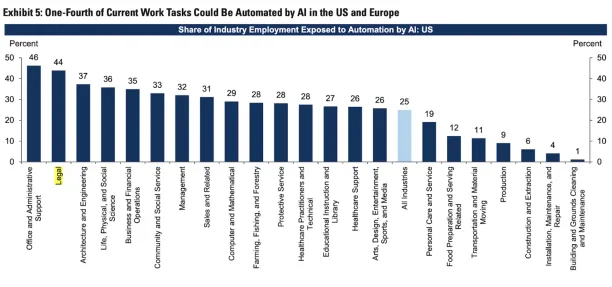
Explore real-life and potential generative AI legal use cases with some real life examples:
What is legal generative AI?
Generative AI (GenAI) is a branch of artificial intelligence (AI) that creates new content—such as text, images, or audio—by learning from existing data patterns. These advanced systems can mimic human creativity and decision-making, offering significant potential to automate tasks.
For example, the latest large language model by OpenAI, namely GPT-4, with its advanced reasoning abilities, has even passed the bar exam, scoring in the top 10% of test takers.4 This score showcases its potential for use in legal fields, particularly for in-house counsel.
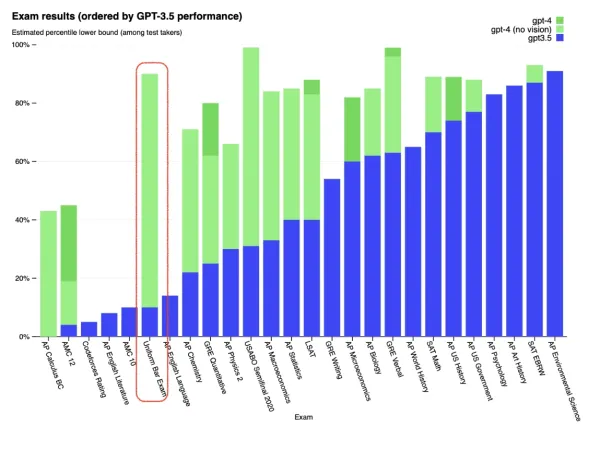
The human-like AI generated content has led to various applications, ranging from generating written content to AI generated images. One of the key applications of GenAI is in the legal industry, where it automates tasks like drafting contracts and legal documents. This has become increasingly valuable for corporate legal departments and law firms seeking to streamline operations.
What are the potential generative AI legal use cases?
Below is a table illustrating how the top 12 use cases are applied across various legal sectors, including law firms, courts, tax firms, and legal departments:
| Use Case | Courts | Law firm | Corp legal department | Corp tax department | Tax firm |
|---|---|---|---|---|---|
| Legal research | ✅ | ✅ | ✅ | ||
| Document review & summarization | ✅ | ✅ | ✅ | ✅ | ✅ |
| Drafting contract, brief or memo | ✅ | ✅ | ✅ | ||
| Extracting contract data | ✅ | ||||
| Contract analysis and negotiation | ✅ | ✅ | |||
| Compliance and regulatory monitoring | ✅ | ✅ | |||
| Due diligence | ✅ | ||||
| Intellectual property management | ✅ | ✅ | |||
| Legal chatbots | ✅ | ✅ | ✅ | ||
| Tax research | ✅ | ✅ | |||
| Tax return preparation | ✅ | ✅ | |||
| Tax advisory | ✅ |
1- Compliance and regulatory monitoring
AI-powered systems can monitor evolving regulations and ensure that businesses remain compliant with relevant laws and industry standards, alerting them to any changes that may impact their operations.
2- Contract analysis and negotiation
AI tools can review contracts to identify important clauses, flag potential issues, and suggest revisions based on best practices, simplifying the negotiation process and reducing the risk of disputes.
3- Document drafting and review
Generative AI can assist in drafting legal documents such as contracts, wills, and pleadings, by using pre-defined templates and input data. It can also help review existing documents for errors, inconsistencies, or potential legal issues.
4- Due diligence
In corporate transactions, generative AI can help automate the process of reviewing large volumes of documents, identifying potential legal risks and issues, and generating due diligence reports.
5- Intellectual property management
Generative AI can help in the process of patent analysis, trademark searches, and infringement detection, making it easier for attorneys to manage their clients’ intellectual property portfolios.
6- Legal research
Generative AI tools can expedite legal research by quickly searching and analyzing relevant case law, legislation, and secondary sources, enabling legal professionals to access pertinent information with ease.
7- Legal chatbots
Generative AI can power chatbots that provide basic legal guidance, answering common questions or directing users to appropriate resources or services, making legal assistance more accessible to the public.
8. Drafting contracts, briefs, or memos
Generative AI can assist legal professionals in drafting various documents, including contracts, legal briefs, and memos.By analyzing vast datasets of legal texts, AI can propose relevant clauses, structure documents appropriately, and ensure alignment with current legal standards, thereby streamlining the drafting process.
9. Extracting contract data
AI-powered tools can efficiently extract pertinent data from contracts, such as parties involved, terms, obligations, and deadlines. This automation reduces manual review time, minimizes errors, and facilitates better contract management and compliance tracking.
10. Tax research
AI tools can swiftly analyze extensive tax codes, regulations, and case law to provide insights on tax implications for various scenarios. This accelerates the research process, aids in identifying relevant precedents, and supports tax planning and compliance efforts.
11. Tax return preparation
Generative AI can assist in preparing tax returns by processing financial data, identifying applicable deductions, and ensuring compliance with current tax laws. This automation reduces the risk of errors, accelerates preparation time, and enhances accuracy in tax filings.
12. Tax advisory
AI-driven analytics can support tax advisory services by modeling different tax strategies, forecasting outcomes, and identifying potential risks. By processing large datasets, AI provides advisors with data-driven insights, enhancing decision-making and offering clients informed tax planning options.
What are some real life applications of generative AI in legal issues?
Law firms have started to use AI softwares that incorporate LLMs like ChatGPT, which are customized for the legal system. Here are some real-life examples:
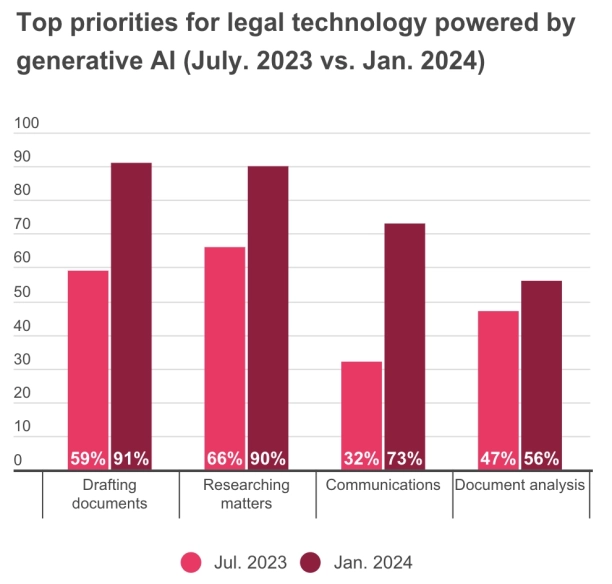
1- ChatGPT
In September 2023, Lord Justice Birss became the first known British judge to use an AI chatbot in a judgment. This marked a milestone in AI adoption within the judicial system.7
In 2024, Judge Kevin Newsom of the U.S. Court of Appeals for the Eleventh Circuit used ChatGPT to interpret the term “physically restrained” in a sentencing appeal. Initially skeptical, he found the AI’s definition—”limiting or preventing someone’s movement by using physical force or some kind of device”—sensible. This experience led him to advocate for AI tools in legal interpretation, while stressing the need for human oversight.
Explore such real-life legal ChatGPT use cases and more.
2- CoCounsel
For example, Casetext released the first AI legal assistant CoCounsel, which is powered by GPT-4. CoCounsel mentions that none of the client data are sent to the AI companies for the purpose of using them as large language model training data. The assistant can automate many of the manual legal work, such as:
- Reviewing documents
- Preparing for a deposition
- Summarizing legal documents
3- Harvey
Harvey is one of the generative AI platforms, using OpenAI’s latest LLMs that are fine-tuned for legal issues. It is open to the use of 3,500 lawyers in 43 law offices.8 Harvey functions similarly to the CoCounsel, in automating the similar legal tasks.
Concerning data privacy, Harvey diligently addresses clients’ compliance requirements by anonymizing user information and removing data after a specified duration.9 Users have the option to request data deletion at any point in time.
Will generative AI models replace human labor in the legal field?
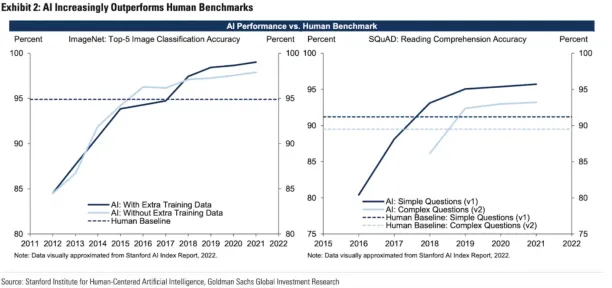
According to many benchmarks, generative AI tools are outperforming human performance in many tasks (see Figure 3 for an example). This raises concerns whether AI will replace human jobs altogether.
Research by OpenAI and University of Pennsylvania indicates that approximately 80% of the American workforce may experience a minimum of 10% of their job tasks being impacted by the implementation of large language models.11
Although generative AI has started to automate a lot of legal work, legal professionals state that it doesn’t seem possible from this point that AI will replace all human involvement in the legal landscape.12 On the other hand, with generative AI automating most of the time consuming manual tasks, they believe that lawyers will be able to tackle more unique and creative tasks about the legal issues.13
What are the legal problems around the use of generative AI?
Besides the use of generative AI in legal issues, there are legal and ethical problems raised by the very use of generative AI, such as the copyright law concerns and intellectual property rights for AI generated works. If you want to learn more about these, you can check our detailed articles:
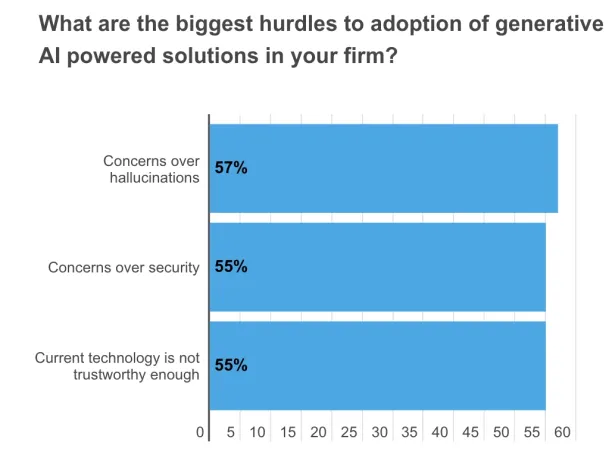
What are legal GenAI tools?
Legal AI refers to the use of artificial intelligence, including generative AI, to automate, enhance, and streamline legal tasks such as contract analysis, legal research, compliance, and document drafting.
Explore a range of AI and generative AI-driven tools designed for legal professionals, lawyers, and law firms through our comprehensive vendor benchmark on Legal AI Software.
If you have questions or need help in finding vendors, we can help:
External Links
- 1. Lawyers gear up for generative AI.
- 2. “Global Economics Analyst The Potentially Large Effects of Artificial Intelligence on Economic Growth (BriggsKodnani).” ANSA, 26 March 2023. Accessed 16 April 2023.
- 3. “Global Economics Analyst The Potentially Large Effects of Artificial Intelligence on Economic Growth (BriggsKodnani).” ANSA, 26 March 2023. Accessed 16 April 2023.
- 4. GPT-4 | OpenAI.
- 5. GPT-4 | OpenAI.
- 6. LexisNexis Survey above.
- 7. British judge admits using 'jolly useful' ChatGPT to write ruling | Science, Climate & Tech News | Sky News. Sky
- 8. Will artificial intelligence replace your lawyer–and will its name be Harvey? | Fortune. Fortune
- 9. Harvey, which uses AI to answer legal questions, lands cash from OpenAI | TechCrunch. TechCrunch
- 10. Goldman Sachs Global Investment Research above
- 11. [2303.10130] GPTs are GPTs: An Early Look at the Labor Market Impact Potential of Large Language Models.
- 12. Supra note 3.
- 13. Will AI replace lawyers? Two legal experts weigh in | Fox Business. Fox Business
- 14. LexisNexis Survey above.


Comments
Your email address will not be published. All fields are required.